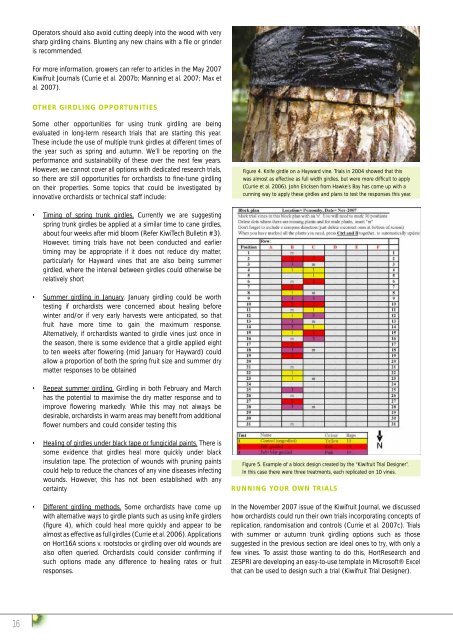Thirsty vines Summer girdling Compost teas Organic marketing The ...
Thirsty vines Summer girdling Compost teas Organic marketing The ...
Thirsty vines Summer girdling Compost teas Organic marketing The ...
You also want an ePaper? Increase the reach of your titles
YUMPU automatically turns print PDFs into web optimized ePapers that Google loves.
16<br />
Operators should also avoid cutting deeply into the wood with very<br />
sharp <strong>girdling</strong> chains. Blunting any new chains with a fi le or grinder<br />
is recommended.<br />
For more information, growers can refer to articles in the May 2007<br />
Kiwifruit Journals (Currie et al. 2007b; Manning et al. 2007; Max et<br />
al. 2007).<br />
OTHER GIRDLING OPPORTUNITIES<br />
Some other opportunities for using trunk <strong>girdling</strong> are being<br />
evaluated in long-term research trials that are starting this year.<br />
<strong>The</strong>se include the use of multiple trunk girdles at different times of<br />
the year such as spring and autumn. We’ll be reporting on the<br />
performance and sustainability of these over the next few years.<br />
However, we cannot cover all options with dedicated research trials,<br />
so there are still opportunities for orchardists to fi ne-tune <strong>girdling</strong><br />
on their properties. Some topics that could be investigated by<br />
innovative orchardists or technical staff include:<br />
• Timing of spring trunk girdles. Currently we are suggesting<br />
spring trunk girdles be applied at a similar time to cane girdles,<br />
about four weeks after mid bloom (Refer KiwiTech Bulletin #3).<br />
However, timing trials have not been conducted and earlier<br />
timing may be appropriate if it does not reduce dry matter,<br />
particularly for Hayward <strong>vines</strong> that are also being summer<br />
girdled, where the interval between girdles could otherwise be<br />
relatively short<br />
• <strong>Summer</strong> <strong>girdling</strong> in January. January <strong>girdling</strong> could be worth<br />
testing if orchardists were concerned about healing before<br />
winter and/or if very early harvests were anticipated, so that<br />
fruit have more time to gain the maximum response.<br />
Alternatively, if orchardists wanted to girdle <strong>vines</strong> just once in<br />
the season, there is some evidence that a girdle applied eight<br />
to ten weeks after fl owering (mid January for Hayward) could<br />
allow a proportion of both the spring fruit size and summer dry<br />
matter responses to be obtained<br />
• Repeat summer <strong>girdling</strong>. Girdling in both February and March<br />
has the potential to maximise the dry matter response and to<br />
improve fl owering markedly. While this may not always be<br />
desirable, orchardists in warm areas may benefi t from additional<br />
fl ower numbers and could consider testing this<br />
• Healing of girdles under black tape or fungicidal paints. <strong>The</strong>re is<br />
some evidence that girdles heal more quickly under black<br />
insulation tape. <strong>The</strong> protection of wounds with pruning paints<br />
could help to reduce the chances of any vine diseases infecting<br />
wounds. However, this has not been established with any<br />
certainty<br />
• Different <strong>girdling</strong> methods. Some orchardists have come up<br />
with alternative ways to girdle plants such as using knife girdlers<br />
(fi gure 4), which could heal more quickly and appear to be<br />
almost as effective as full girdles (Currie et al. 2006). Applications<br />
on Hort16A scions v. rootstocks or <strong>girdling</strong> over old wounds are<br />
also often queried. Orchardists could consider confi rming if<br />
such options made any difference to healing rates or fruit<br />
responses.<br />
Figure 4. Knife girdle on a Hayward vine. Trials in 2004 showed that this<br />
was almost as effective as full width girdles, but were more diffi cult to apply<br />
(Currie et al. 2006). John Ericksen from Hawke’s Bay has come up with a<br />
cunning way to apply these girdles and plans to test the responses this year.<br />
Figure 5. Example of a block design created by the “Kiwifruit Trial Designer”.<br />
In this case there were three treatments, each replicated on 10 <strong>vines</strong>.<br />
RUNNING YOUR OWN TRIALS<br />
In the November 2007 issue of the Kiwifruit Journal, we discussed<br />
how orchardists could run their own trials incorporating concepts of<br />
replication, randomisation and controls (Currie et al. 2007c). Trials<br />
with summer or autumn trunk <strong>girdling</strong> options such as those<br />
suggested in the previous section are ideal ones to try, with only a<br />
few <strong>vines</strong>. To assist those wanting to do this, HortResearch and<br />
ZESPRI are developing an easy-to-use template in Microsoft® Excel<br />
that can be used to design such a trial (Kiwifruit Trial Designer).


